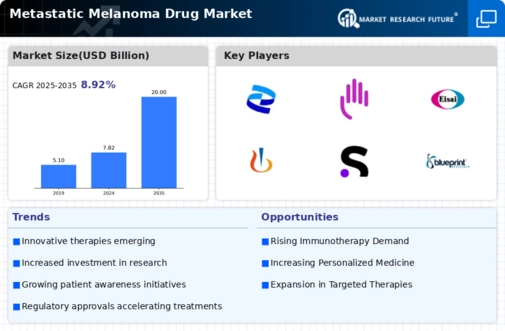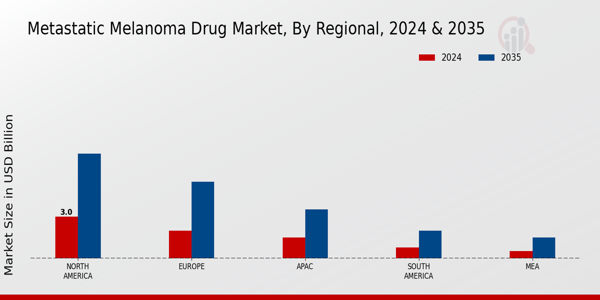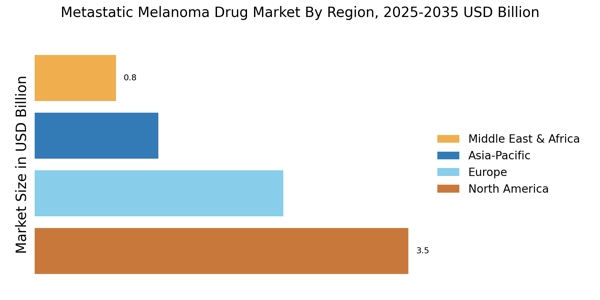Advancements in Personalized Medicine
The evolution of personalized medicine is transforming the landscape of the Metastatic Melanoma Drug Market. Tailored therapies that target specific genetic mutations in melanoma cells are gaining traction, leading to improved patient outcomes. For instance, the introduction of BRAF and MEK inhibitors has revolutionized treatment protocols, offering more effective options for patients with specific genetic profiles. This shift towards personalized treatment not only enhances efficacy but also minimizes adverse effects, making therapies more appealing to patients and healthcare providers alike. As the understanding of melanoma biology deepens, the market is likely to witness a surge in the development of targeted therapies, which could potentially reshape treatment paradigms and drive growth in the Metastatic Melanoma Drug Market.
Growing Patient Awareness and Advocacy
The heightened awareness and advocacy surrounding metastatic melanoma are driving factors in the Metastatic Melanoma Drug Market. Increased educational campaigns and support from patient advocacy groups have led to a more informed patient population. As individuals become more aware of the symptoms and risks associated with melanoma, they are more likely to seek early diagnosis and treatment. This proactive approach not only enhances patient outcomes but also stimulates demand for effective therapies. Furthermore, advocacy efforts are pushing for better access to treatments and funding for research, which could lead to the development of new drugs. Consequently, the growing patient awareness and advocacy are expected to play a significant role in shaping the future of the Metastatic Melanoma Drug Market.
Rising Investment in Oncology Research
The surge in investment directed towards oncology research is a crucial driver for the Metastatic Melanoma Drug Market. With an increasing number of public and private entities recognizing the urgency of addressing cancer, funding for melanoma research has seen a notable rise. Reports suggest that oncology research funding has increased by over 20% in recent years, reflecting a growing commitment to developing effective treatments. This influx of capital not only supports clinical trials but also fosters collaboration between academic institutions and pharmaceutical companies, leading to innovative solutions. As research progresses, the Metastatic Melanoma Drug Market is likely to benefit from the introduction of novel therapies that address unmet medical needs.
Growing Incidence of Metastatic Melanoma
The rising incidence of metastatic melanoma is a pivotal driver for the Metastatic Melanoma Drug Market. Recent statistics indicate that melanoma cases have been increasing steadily, with an estimated annual growth rate of approximately 3%. This trend is likely to escalate the demand for effective treatment options, thereby propelling market growth. As awareness of skin cancer rises, more individuals are seeking early diagnosis and treatment, which further emphasizes the need for innovative therapies. The increasing prevalence of risk factors, such as excessive UV exposure and tanning bed usage, contributes to this upward trajectory. Consequently, pharmaceutical companies are motivated to invest in research and development to address this growing patient population, which is expected to significantly impact the Metastatic Melanoma Drug Market.
Increased Regulatory Support for Innovative Therapies
Regulatory bodies are increasingly supportive of innovative therapies, which serves as a significant driver for the Metastatic Melanoma Drug Market. Initiatives aimed at expediting the approval process for breakthrough therapies have been implemented, allowing for faster access to novel treatments. For example, the FDA's Breakthrough Therapy Designation has facilitated the rapid development of promising drugs, thereby enhancing the market landscape. This regulatory environment encourages pharmaceutical companies to invest in research and development, knowing that their innovative solutions may receive expedited approval. As a result, the influx of new therapies is expected to invigorate the Metastatic Melanoma Drug Market, providing patients with more options and potentially improving survival rates.



















Leave a Comment